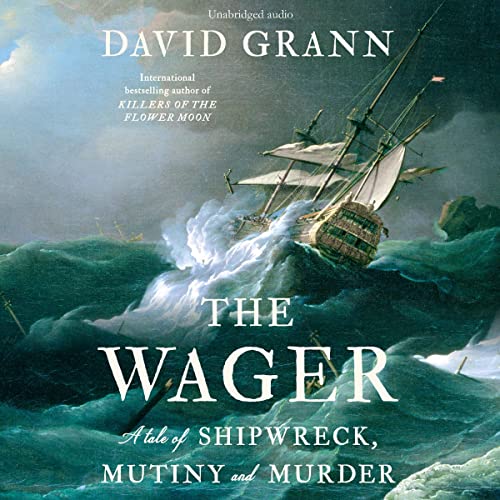The Wager: How David Grann Uncovered a Shocking Truth About Empire
In this thrilling account of a modern-day Indiana Jones adventure, David Grann reveals how he uncovered a shocking truth about empire through his investigation of the Wager Mutiny.
Introduction
Hello, my name is Fred Wilson and I’m a seasoned blog writer who loves action and adventure movies as well as stories of discovery and danger. I have always been fascinated by the mysteries and mysteries of the past, and how they can shed light on the present and the future.
That’s why I was hooked when I read David Grann’s latest book The Wager: A Tale of Shipwreck, Mutiny and Murder. Grann is one of my favorite authors and journalists, who has a knack for finding and telling incredible stories that are both true and captivating. He has written several best-selling books that have been adapted into films, such as Killers of the Flower Moon: The Osage Murders and the Birth of the FBI (which was directed by Martin Scorsese) and The Lost City of Z: A Tale of Deadly Obsession in the Amazon (which starred Charlie Hunnam, Sienna Miller, Robert Pattinson, and Tom Holland).
In his new book, Grann takes us on a journey to one of the most remote and inhospitable places on earth, where he uncovers a shocking truth about empire through his investigation of the Wager Mutiny, a historical event that took place in 1742 during the War of Jenkins’ Ear between Britain and Spain. The book is a gripping saga of survival, duty, and leadership, and it also challenges the way we think about history and its consequences.
In this article, I will share with you my insights on what makes this book so captivating and compelling. I will also show you how Grann uses his storytelling skills and his historical research to create an immersive and enlightening experience for his readers.

The Wager: A Brief Overview
David Grann is an American journalist and a staff writer for The New Yorker, who has won several awards for his reporting and writing. He is also a master of narrative nonfiction, a genre that combines factual accuracy with literary techniques to create engaging and compelling stories.
His fifth nonfiction book, The Wager: A Tale of Shipwreck, Mutiny and Murder, is based on one of his most intriguing research projects, which he first wrote about in a 2018 article for The New Yorker titled “The White Darkness”. In the article, he chronicled the exploits of Henry Worsley, a British adventurer and former army officer, who attempted to cross Antarctica alone and unaided in 2015, following the footsteps of his hero Ernest Shackleton, the legendary polar explorer.
Worsley was also obsessed with another historical figure, John Byron, the grandfather of the famous poet Lord Byron, and the captain of the HMS Wager, a British warship that was part of a fleet sent to attack Spanish colonies in South America in 1740. The fleet was led by Admiral George Anson, who had a grand ambition to circumnavigate the globe and seize the Spanish treasure ships.
However, the expedition turned out to be a disaster, as the fleet was battered by storms, diseases, and enemy attacks. The Wager was separated from the rest of the fleet and wrecked on a desolate island off the coast of Patagonia, where the captain and the crew faced starvation, cold, and mutiny.
The Wager Mutiny is one of the most fascinating and dramatic episodes in naval history, as it involved a clash of personalities, a struggle for authority, and a desperate fight for survival. It also had far-reaching implications for the British Empire, as the captain and the crew who ended up on trial were not only accused of mutiny, but also challenged the very idea of empire and its legitimacy.
Grann’s book tells the true story of the Wager Mutiny, based on his extensive research of historical documents, such as journals, letters, court records, and maps. He also retraces the steps of the survivors, who tried to escape from the island and reach civilization, by traveling to Patagonia and following their routes. He also interviews some of the descendants of the mutineers, who still live in Chile and Argentina, and who have preserved some of their ancestors’ stories and artifacts.
The Power of Storytelling
One of the reasons why I love Grann’s books is that he is a master of storytelling. He knows how to use literary techniques, such as vivid descriptions, dialogue, flashbacks, foreshadowing, suspenseful twists, etc., to create an immersive and captivating experience for his readers. He also knows how to balance historical facts with dramatic elements, without compromising the accuracy or the integrity of his sources.
For example, in his book The Wager, he introduces us to the main characters of the story, such as Captain John Byron, Lieutenant David Cheap, Midshipman John Bulkeley, and Gunner John Cummins, by describing their physical appearance, personality, background, and motivation. He also gives us a glimpse into their thoughts and feelings, by quoting from their journals or letters, or by imagining what they might have said or done in certain situations.
He also sets the scene for the story, by describing the harsh and hostile environment of the island where the Wager was wrecked, and the challenges and dangers that the crew faced. He uses sensory details, such as sounds, smells, colors, and textures, to make us feel like we are there with them, witnessing their ordeal. He also uses metaphors and similes, such as comparing the island to a prison, or the ship to a coffin, to convey the mood and the tone of the story.
He also creates a sense of suspense and tension, by using flashbacks, foreshadowing, and cliffhangers, to keep us hooked and curious about what will happen next. He also surprises us with unexpected twists and turns, such as revealing the fate of some of the characters, or the outcome of some of the events, that we might not have anticipated. He also builds up to a climax, where he reveals the shocking truth about the Wager Mutiny, and its impact on the British Empire and its history.
He also engages us emotionally, by making us care about the characters and their fate, by showing their strengths and weaknesses, their hopes and fears, their conflicts and dilemmas, their loyalty and betrayal, their courage and cowardice, their heroism and villainy. He also makes us empathize with their suffering and their joy, their despair and their triumph, their loss and their gain, their death and their survival.
He also entertains us intellectually, by making us think about the themes and the messages of the story, such as the nature of survival, duty, and leadership, the role of chance and fate, the meaning of honor and justice, the value of friendship and love, the cost of violence and war, the power of storytelling and history.
The Meaning Behind History
Another reason why I admire Grann’s books is that he challenges conventional narratives about history, by revealing hidden or overlooked aspects or perspectives, that might change the way we understand the past and its consequences. He also shows us how history is not only about facts, but also about interpretations, and how both people and nations tell and manipulate history, to suit their own agendas and interests.
For example, in his book The Wager, he shows us how the Wager Mutiny was not only a naval incident, but also a political and ideological controversy, that had implications for the British Empire and its legitimacy. He shows us how the mutineers, who were mostly lower-ranking sailors, were dissatisfied with the harsh and unfair treatment they received from their superiors, and how they questioned the authority and the competence of their officers, especially Captain Byron, who they blamed for the shipwreck and the subsequent hardships.
He also shows us how the mutineers, who decided to abandon the island and try to reach the Spanish colonies, where they hoped to find refuge and passage back to England, were accused of treason and desertion, and how they defended themselves by claiming that they were acting in self-preservation and in accordance with the law of nature. He also shows us how the mutineers, who were eventually captured by the Spanish and brought back to England, where they faced a court-martial, were not only charged with mutiny, but also challenged the very idea of empire, by arguing that they had a right to choose their own allegiance, and that they owed no loyalty to a king or a country that had abandoned them.
He also shows us how the trial of the mutineers, which was widely publicized and debated, exposed the flaws and the contradictions of the British Empire, and how it sparked a political and social movement, known as the “Wagerites”, who supported the cause of the mutineers, and who advocated for more democracy and equality, and for less tyranny and oppression. He also shows us how the trial of the mutineers, which resulted in a mixed verdict, with some being acquitted and some being condemned, influenced the future of the British Empire, and how it foreshadowed the American Revolution, which was also a rebellion against imperial rule and taxation.
He also shows us how the story of the Wager Mutiny, which was recorded and retold by some of the survivors, such as John Bulkeley and John Cummins, who wrote memoirs of their adventures, was also distorted and embellished, to suit their own purposes and interests.
He also shows us how some of the details and the events of the Wager Mutiny, such as the names and the fates of some of the characters, or the locations and the dates of some of the incidents, were lost or forgotten, and how they were rediscovered and verified by Grann, through his meticulous and adventurous investigation.
Conclusion
In conclusion, I hope that I have given you a glimpse of what makes David Grann’s book The Wager: A Tale of Shipwreck, Mutiny and Murder so captivating and compelling. I hope that I have also shown you how Grann uses his storytelling skills and his historical research to create an immersive and enlightening experience for his readers.
Grann’s book is not only a thrilling account of a modern-day Indiana Jones adventure, but also a revealing exploration of the meaning behind history, and how it shapes our understanding of ourselves and our world. It is also a testament to the power of curiosity and courage, and the importance of seeking and telling the truth, no matter how difficult or dangerous it might be.
If you are a fan of action and adventure movies, as well as stories of discovery and danger, I highly recommend that you read this book. You will not regret it. You will be amazed, entertained, and inspired by Grann’s remarkable journey and his remarkable book.









